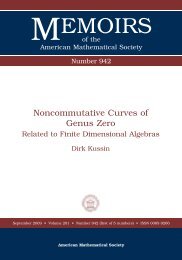University of Paderborn Department of Mathematics Diploma Thesis ...
University of Paderborn Department of Mathematics Diploma Thesis ...
University of Paderborn Department of Mathematics Diploma Thesis ...
You also want an ePaper? Increase the reach of your titles
YUMPU automatically turns print PDFs into web optimized ePapers that Google loves.
3.4. STABLE IDEALS WITH THE SAME HILBERT POLYNOMIAL 71Remark 3.42. Let I, J ⊂ R be saturated stable ideals with p R/I (z) = c = p R/J (z),c ∈ N. We know that the double saturation <strong>of</strong> I and J equals R. Hence, if any <strong>of</strong> thecontractions within the sequence <strong>of</strong> paired contractions and expansions used to take I toJ provided the whole ring R, we would not be able to perform any expansion any moreand could never reach the ideal J. We claim that this case cannot appear, if we followthe procedure in the pro<strong>of</strong> <strong>of</strong> Theorem 3.32. By Lemma 3.17, there is either a sequence <strong>of</strong>monomials whose contractions take I to its double saturation, and a sequence <strong>of</strong> monomialswhose contractions take J to its double saturation. These contractions are exactly those,which we used in Proposition 3.28 and Theorem 3.32 to perform pairs <strong>of</strong> contractions andexpansions to compute one ideal from the other. Since the double saturation <strong>of</strong> I and Jequals R, in both cases the last contraction performed before reaching R is the contraction<strong>of</strong> 1 (i.e. x n−1 is removed from the set <strong>of</strong> generators and replaced by 1, which provides thewhole ring R). Hence, the last contraction taking I to its double saturation equals thelast contraction taking J to its double saturation. But in the pro<strong>of</strong> <strong>of</strong> Proposition 3.28,we showed that we can omit these contractions, when we compute J from I by pairs <strong>of</strong>contractions and expansions. Thus, when using the pairs <strong>of</strong> expansions and contractions<strong>of</strong> Proposition 3.28 and Theorem 3.32, it cannot happen that any <strong>of</strong> the ideals computedwithin the process equals the whole ring R.Next, we will prove by induction that all saturated stable ideals with the same Hilbertpolynomial are linked by finite sequences <strong>of</strong> contractions and expansions.Theorem 3.43. All saturated stable ideals with the same Hilbert polynomial are linked byfinite sequences <strong>of</strong> contractions and expansions.Pro<strong>of</strong>. Let I, J ⊂ R be saturated stable ideals with p R/I (z) = p R/J (z). We may assumep R/I (z) ≠ 0, because otherwise there is nothing to prove. As mentioned above, we doinduction on the degree d := deg p R/I (z).The assertion is true for d = 0 by Lemma 3.41. Now assume d > 0. Since I and J aresaturated stable ideals in R, we know that the variable x n does not appear in any <strong>of</strong> theirmonomial generators. Hence, we can view I and J as possibly non-saturated stable idealsĪ and ¯J in ¯R := K[x 0 , . . . , x n−1 ].Claim. p ¯R/ Ī(z) = p ¯R/ ¯J(z).Pro<strong>of</strong> <strong>of</strong> the Claim. By the exact sequence0 −−−→ R/I(−1)x n−−−→ R/I −−−→ R/(I + xn R) −−−→ 0,it follows p R/(I+xnR)(z) = p R/I (z) − p R/I (z − 1). Similarly we obtain from0 −−−→ R/J(−1)p R/(J+xnR)(z) = p R/J (z) − p R/J (z − 1). Sincex n−−−→ R/J −−−→ R/(J + xn R) −−−→ 0R/(I + x n R) ∼ = (R/x n R)/((I + x n R)/x n R) ∼ = ¯R/Ī
















